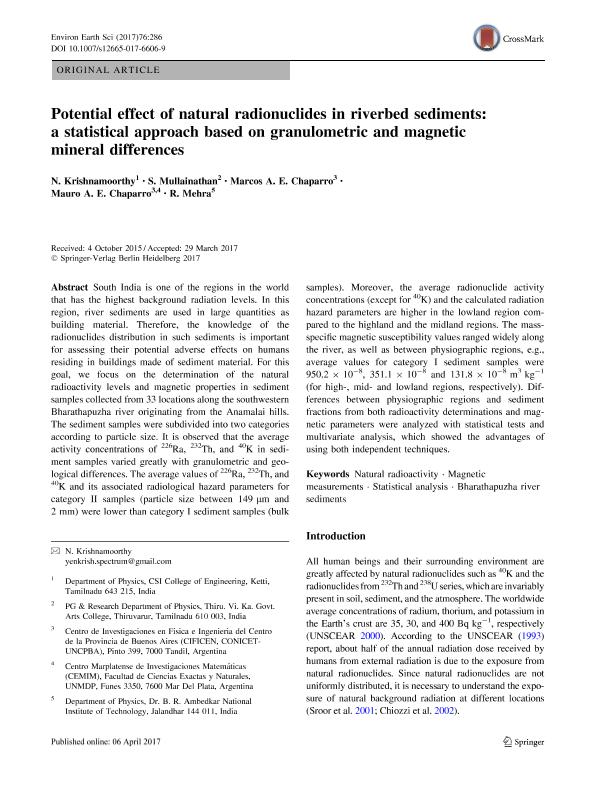Mostrar el registro sencillo del ítem
dc.contributor.author
Krishnamoorthy, N.
dc.contributor.author
Mullainathan, S.
dc.contributor.author
Chaparro, Marcos Adrián Eduardo

dc.contributor.author
Chaparro, Mauro Alejandro Eduardo

dc.contributor.author
Mehra, R.
dc.date.available
2018-09-03T22:04:12Z
dc.date.issued
2017-04
dc.identifier.citation
Krishnamoorthy, N.; Mullainathan, S.; Chaparro, Marcos Adrián Eduardo; Chaparro, Mauro Alejandro Eduardo; Mehra, R.; Potential effect of natural radionuclides in riverbed sediments: a statistical approach based on granulometric and magnetic mineral differences; Springer Verlag Berlín; Environmental Earth Sciences; 76; 7; 4-2017; 1-16; 286
dc.identifier.issn
1866-6280
dc.identifier.uri
http://hdl.handle.net/11336/58197
dc.description.abstract
South India is one of the regions in the world that has the highest background radiation levels. In this region, river sediments are used in large quantities as building material. Therefore, the knowledge of the radionuclides distribution in such sediments is important for assessing their potential adverse effects on humans residing in buildings made of sediment material. For this goal, we focus on the determination of the natural radioactivity levels and magnetic properties in sediment samples collected from 33 locations along the southwestern Bharathapuzha river originating from the Anamalai hills. The sediment samples were subdivided into two categories according to particle size. It is observed that the average activity concentrations of 226Ra, 232Th, and 40K in sediment samples varied greatly with granulometric and geological differences. The average values of 226Ra, 232Th, and 40K and its associated radiological hazard parameters for category II samples (particle size between 149 μm and 2 mm) were lower than category I sediment samples (bulk samples). Moreover, the average radionuclide activity concentrations (except for 40K) and the calculated radiation hazard parameters are higher in the lowland region compared to the highland and the midland regions. The mass-specific magnetic susceptibility values ranged widely along the river, as well as between physiographic regions, e.g., average values for category I sediment samples were 950.2 × 10−8, 351.1 × 10−8 and 131.8 × 10−8 m3 kg−1 (for high-, mid- and lowland regions, respectively). Differences between physiographic regions and sediment fractions from both radioactivity determinations and magnetic parameters were analyzed with statistical tests and multivariate analysis, which showed the advantages of using both independent techniques.
dc.format
application/pdf
dc.language.iso
eng
dc.publisher
Springer Verlag Berlín

dc.rights
info:eu-repo/semantics/openAccess
dc.rights.uri
https://creativecommons.org/licenses/by-nc-sa/2.5/ar/
dc.subject
Bharathapuzha River Sediments
dc.subject
Magnetic Measurements
dc.subject
Natural Radioactivity
dc.subject
Statistical Analysis
dc.subject.classification
Meteorología y Ciencias Atmosféricas

dc.subject.classification
Ciencias de la Tierra y relacionadas con el Medio Ambiente

dc.subject.classification
CIENCIAS NATURALES Y EXACTAS

dc.title
Potential effect of natural radionuclides in riverbed sediments: a statistical approach based on granulometric and magnetic mineral differences
dc.type
info:eu-repo/semantics/article
dc.type
info:ar-repo/semantics/artículo
dc.type
info:eu-repo/semantics/publishedVersion
dc.date.updated
2018-09-03T19:59:40Z
dc.identifier.eissn
1866-6299
dc.journal.volume
76
dc.journal.number
7
dc.journal.pagination
1-16; 286
dc.journal.pais
Alemania

dc.journal.ciudad
Berlin
dc.description.fil
Fil: Krishnamoorthy, N.. CSI College of Engineering; India
dc.description.fil
Fil: Mullainathan, S.. Thiru.Vi.Ka Govt.Arts College; India
dc.description.fil
Fil: Chaparro, Marcos Adrián Eduardo. Universidad Nacional del Centro de la Provincia de Buenos Aires. Centro de Investigaciones en Física e Ingeniería del Centro de la Provincia de Buenos Aires. - Consejo Nacional de Investigaciones Científicas y Técnicas. Centro Científico Tecnológico Conicet - Tandil. Centro de Investigaciones en Física e Ingeniería del Centro de la Provincia de Buenos Aires. - Provincia de Buenos Aires. Gobernación. Comisión de Investigaciones Científicas. Centro de Investigaciones en Física e Ingeniería del Centro de la Provincia de Buenos Aires; Argentina
dc.description.fil
Fil: Chaparro, Mauro Alejandro Eduardo. Universidad Nacional del Centro de la Provincia de Buenos Aires. Centro de Investigaciones en Física e Ingeniería del Centro de la Provincia de Buenos Aires. - Consejo Nacional de Investigaciones Científicas y Técnicas. Centro Científico Tecnológico Conicet - Tandil. Centro de Investigaciones en Física e Ingeniería del Centro de la Provincia de Buenos Aires. - Provincia de Buenos Aires. Gobernación. Comisión de Investigaciones Científicas. Centro de Investigaciones en Física e Ingeniería del Centro de la Provincia de Buenos Aires; Argentina. Universidad Nacional de Mar del Plata. Facultad de Ciencias Exactas y Naturales; Argentina
dc.description.fil
Fil: Mehra, R.. Dr. B. R. Ambedkar National Institute of Technology; India
dc.journal.title
Environmental Earth Sciences
dc.relation.alternativeid
info:eu-repo/semantics/altIdentifier/doi/http://dx.doi.org/10.1007/s12665-017-6606-9
dc.relation.alternativeid
info:eu-repo/semantics/altIdentifier/url/https://link.springer.com/article/10.1007%2Fs12665-017-6606-9
Archivos asociados
